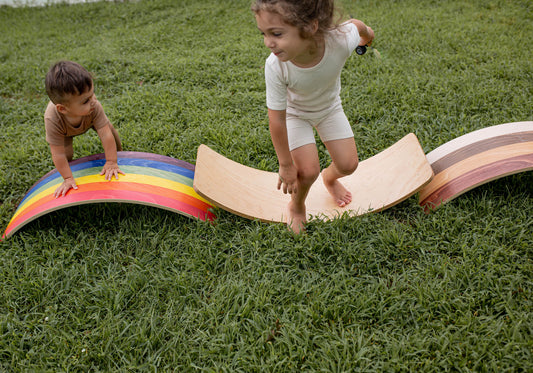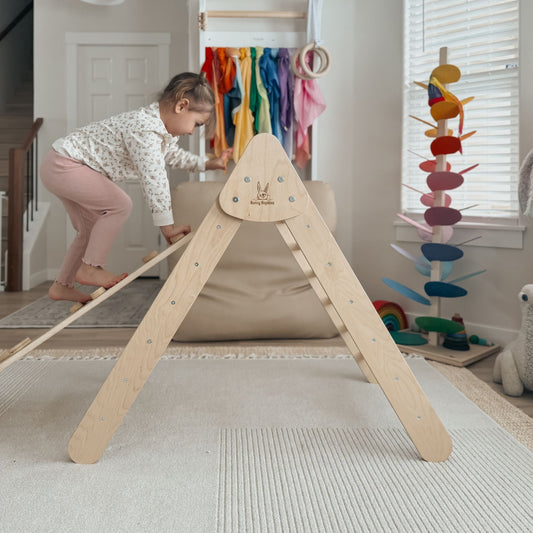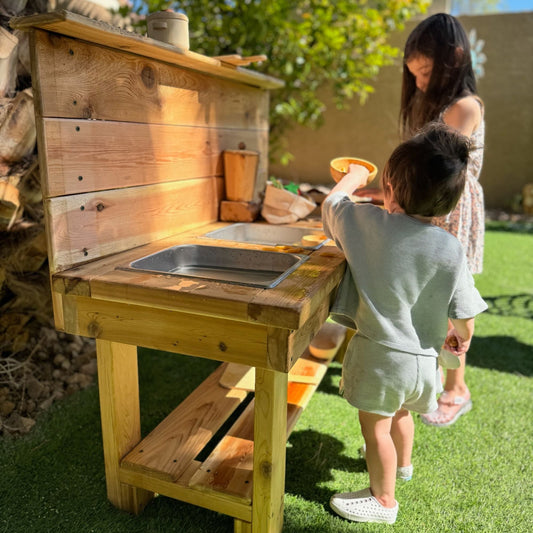
Screen Time vs. Play Time: Why Open-Ended Active Play Is Essential for Child Development
Shamik DasguptaShare
The Digital Dilemma: Screens vs. Active Play
Modern technology has made screens nearly unavoidable. While educational apps and shows can have some benefits, too much screen time can crowd out the crucial active play that children need for healthy growth. According to the World Health Organization, children under five “must spend less time sitting watching screens… and have more time for active play” to grow up healthy . In other words, more playtime and less sedentary screen time is a recipe for better physical and mental health.
Excessive screen usage in early childhood has been linked to a range of developmental concerns. A recent review of research found that too much screen time can harm children’s cognitive, language, and social-emotional development . For example, when young kids spend long periods on devices, they have fewer rich interactions with caregivers and peers, potentially impacting language development and social skills . Heavy screen use is also associated with higher risks of childhood obesity, sleep problems, and even anxiety .
Why are these negative effects happening? One reason is that time on a tablet or TV is time not spent running, climbing, imagining, and interacting in the real world. “What we really need to do is bring back play for children,” emphasizes Dr. Juana Willumsen of the WHO, “making the shift from sedentary time to playtime” . Active play engages children’s bodies and brains in ways that screen content simply cannot replicate.
Of course, completely eliminating screens is unrealistic for most families. The goal is balance: ensuring that screen time is limited and high-quality, while giving priority to plenty of active, open-ended play time. As we’ll see, that play time is far from just idle fun – it’s the foundation of healthy child development.
Why Active Play Matters for Development
Play isn’t just joyfully fun for kids – it’s fundamental for their development. You may have heard the famous saying by educator Maria Montessori: “Play is the work of the child.” During active play, children are hard at work building crucial skills in every domain: physical, cognitive, social, and emotional. Here are just a few research-backed benefits of giving kids ample opportunity for active play:
- Better Physical Health: Active play helps children build strong bodies. Running, climbing, balancing and jumping improve cardiovascular fitness, strengthen muscles and bones, and enhance coordination and balance . Kids who play actively tend to have healthier sleep patterns and maintain a healthy weight . In short, moving bodies are growing healthy bodies. By scrambling up a climbing arch or wobbling on a balance board, kids develop gross motor skills and endurance that set the stage for lifelong fitness.
- Improved Confidence and Resilience: Play allows children to test their limits, try new ideas, and sometimes fail safely – all of which builds resilience. For example, when a toddler first tries to climb a Pikler triangle, they may struggle or slip a bit (under a watchful eye). With practice, they gain confidence in their abilities. Overcoming small challenges in play helps kids learn that perseverance leads to success, a mindset that contributes to confidence and emotional resilience. Unstructured play has been identified as a key component in building children’s ability to focus, be creative, and act intentionally even when outcomes are uncertain . Those are exactly the qualities resilient adults need in real life.
- Social and Emotional Skills: Active play often involves imagination and sometimes collaboration. Whether kids are playing “restaurant” in a mud kitchen or taking turns rocking on a wooden balance board, they learn to communicate, negotiate roles, and empathize with playmates. Play is a social laboratory where children practice language and cooperation. Even independent play builds emotional skills – it provides a safe outlet for expressing feelings and working through experiences (think of a child acting out a story with dolls or stuffed animals). Research shows that open-ended play, where children direct the action, can reduce stress and help kids process emotions in a healthy way .
- Cognitive and Creative Growth: Perhaps most surprisingly, active play boosts brain power. Physical activity has been linked to improved concentration and classroom behavior in young children . When kids play, they are also learning how to learn. They make observations (“If I stack these blocks too high, they fall”), solve problems (“How can I get my figurine to the top of this climbing arch?”), and stretch their imagination (“This balance board is a surfboard on a stormy sea!”). In fact, research tells us that open-ended play offers important opportunities for brain development, fostering creativity and flexible thinking . Instead of following scripted scenarios (like a TV show or a toy that does one thing), a child engaged in free play is essentially doing mini experiments and tapping into their innate creativity. Play time really is learning time in disguise.
Considering all these benefits, it’s clear that active play is not a luxury or an “extra” – it’s a necessity for healthy child development. As one Australian health campaign neatly put it: a child’s job is to play, and encouraging kids to be active early on creates healthy habits that can last a lifetime . Now, let’s look specifically at one type of play that Bunny Hopkins is passionate about: open-ended play.
The Power of Open-ended Play
Less is More - Purposeful Playsets promoting active child development - Pikler Triangle, Balance Board, Climbing Arch, Mud Kitchen
One way to encourage more active, open-ended play is to enrich your child’s environment with the right kinds of toys. We’re talking about toys that don’t entertain the child at the push of a button, but rather toys that allow the child to entertain themselves through imagination and movement. Bunny Hopkins specializes in exactly these kinds of toys. Let’s look at a few examples and how they contribute to child development:
- Balance Boards: A wooden balance board is a classic open-ended toy that provides endless fun while building physical skills. Children can rock on it like a seesaw, climb over it, slide toys down it, or flip it to use as a bridge or a stool. As they experiment, they are improving their balance and core strength. Occupational therapists note that balancing on a wobble board activates a child’s vestibular system (inner ear balance mechanism) and core muscles, which in turn helps them develop better posture and even concentration in the long run . Balancing play also teaches cause-and-effect (lean too far and it tips!) and body awareness. Don’t be surprised if that simple wobble board becomes a surfboard on a pretend ocean, a rocking cradle for dolls, or a stage for a stuffed animal performance – the possibilities make it magical.
- Pikler Triangles & Climbing Arches: These mini-indoor climbing frames (originally developed by Dr. Emmi Pikler) have become must-haves for gross motor play. They are basically foldable wooden triangles or arched ladders that toddlers and preschoolers can use to climb, slide, or drape a blanket over to make a fort. Climbing is fantastic for developing gross motor skills, coordination, and courage. Little ones gain upper body strength as they grasp the rungs, and learn to navigate spatial challenges as they figure out where to place hands and feet next. Importantly, they also learn to manage risk: a toddler atop a Pikler triangle is practicing being careful and figuring out how to climb down safely, under an adult’s supervision. This boosts their self-confidence and judgment. A climbing arch adds a different dimension – its curved shape can rock like a boat or be flipped for climbing. Providing a safe outlet for a child’s natural urge to climb can save your furniture from being treated like a jungle gym! Plus, these climbers are open-ended – one day it’s a mountain, the next day it’s a cave or a lemonade stand (with a cloth over it). The child decides.
- Mud Kitchens and Outdoor Play Sets: In a world of indoor electronics, an outdoor mud kitchen invites children to get back to nature – and they love it. A mud kitchen is essentially a pretend play kitchen, usually made of wood, meant to be used outdoors with nature’s ingredients (mud, sand, water, leaves, etc.). This kind of toy facilitates sensory play (squishing mud, pouring water), which is important for brain development and integrating the senses. It also encourages imaginative role-play and social play: kids can mimic cooking, “bake” mud pies, run a pretend café, or concoct potions. They learn cooperation by playing together and taking turns. Perhaps most importantly – it gets children moving and playing outside, where they naturally run around, explore, and connect with the environment. Outdoor active play has additional benefits like fresh air, vitamin D from sunlight, and opportunities for loud, messy play that might not be possible indoors. A mud kitchen or an outdoor playset becomes a stage for creativity while also keeping kids physically active. And yes, everything will get delightfully dirty – that’s part of the learning (and why washable play clothes exist!).
- Other Open-Ended Toys: Even simple additions to your playroom can make a big difference. Consider a set of large building blocks or “loose parts” (like wooden rings, planks, and cones) that kids can stack and arrange into obstacle courses. Stepping stones (soft or wooden spots to hop between) are great for balance and coordination. Costumes or play scarves can spark active pretend play, having children dance, run and act out stories. None of these are high-tech, but they are high-impact for development. The key is to look for kids’ toys that are child-driven – toys that do as little as possible so that the child does more. Bunny Hopkins’ collection of made-in-USA, naturally crafted toys follows this principle, focusing on safe, sustainable materials and open-ended designs that grow with your child.
Tips to Encourage More Play (and Manage Screen Time)
Fostering a love of active play in your child doesn’t mean you must banish all devices. It’s about making play enticing and part of your family’s routine. Here are some practical tips for parents, caregivers, and even educators to encourage more open-ended active play while keeping screen time in check:
- Create Screen-Free Zones or Times: Designate certain areas (like the playroom or dining table) and times of day (such as mornings or an hour before bedtime) as screen-free. When screens are out of sight, kids more readily find something to play with. Fill a low shelf with open-ended toys in a screen-free play space to invite exploration. Consistency is key – if every evening before dinner is “free play time,” children come to expect and enjoy it.
- Model Active Play and Participation: Children learn by observing adults. Show your enthusiasm for play by getting down on the floor to build a tower or going outside to kick a ball. Take family walks, fly kites, go biking – make movement a normal part of life. When kids see you choosing an activity over scrolling on the phone, they’ll follow suit . You can also occasionally join their play world – let them lead you in a game of pretend. Your involvement can make play even more exciting for them (just be sure to let the child’s imagination stay in charge!).
- Provide Open-Ended Toys and Materials: Stock your play area with things like blocks, art supplies, dress-up items, and the larger toys we discussed (balance board, climber, etc.). You don’t need a mountain of toys – just a good variety that can be used in different ways. For example, a set of wooden blocks, some toy animals, and a few scarves can together become a zoo, a farm, a city – anything! High-quality, natural toys made in the USA are a great investment because they’re durable and safe. A well-crafted balance board or Pikler triangle can be used daily for years. Such toys empower kids to create their own fun, reducing the allure of passive screen entertainment.
- Step Back and Allow Unstructured Play: In our busy lives, it’s easy to fill children’s schedules with structured lessons, sports, and planned activities. But be sure to leave room for unstructured downtime, when kids can get “bored” and then invent their own play. This unscheduled time is when their creativity truly blossoms. Resist the urge to direct every game – let your child take the lead and enjoy watching their imagination at work. If they decide the climbing arch is now a spaceship, roll with it! By not intervening too much, you show them that you value their ideas and independence.
- Use Screens Strategically: When you do allow screen time, make it high-quality and interactive if possible. There are some wonderful educational shows and apps out there – choose ones that align with your values (for instance, shows that might spark new play ideas rather than just mindless cartoons). Watching together and asking questions can turn a screen session into a learning experience. And when it’s over, gently encourage an offline activity related to what they watched (“That show about animals was cool. Want to pretend to be zookeepers with your animal toys now?”). By connecting screen content back to real-world play, you bridge the gap between virtual and physical experiences.
Conclusion: Embracing Play for a Brighter Future
References
World Health Organization – Guidelines on physical activity, sedentary behaviour and sleep for children under 5
Source: who.int
Reddy Pulliahgaru, A. et al. (2023) – Effects of Excessive Screen Time on Child Development
Source: pmc.ncbi.nlm.nih.gov
Michigan State University Extension – The Value of Open-Ended Play
Source: canr.msu.edu
Better Health Channel (Victorian State Government) – Benefits of Physical Activity for Children
Source: betterhealth.vic.gov.au
OTHolly (Occupational Therapist) – Benefits of a Toddler Balance Board
Source: otholly.com



